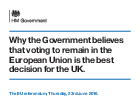The initiative is proving, unsurprisingly, to be politically toxic but there are interesting procurement issues too - so if I were the CPO asked to have handled this procurement exercise here's some of the questions I would have asked:
- Have we processes in place to comply with the EU Regs?
- I assume the business case has been agreed, risk assessed and approved?
- Has the 'do nothing' option or leave to the 'Stay in' campaign been fully evaluated?
- Do we let one contract for design, one for print, one for packaging, one for delivery, and one over-arching contract?
- The budget is separate for 'production' and 'print and delivery', what do we mean by 'production' - is that 'design'?
- The design appears to include every other page as a colour picture, given that this is primarily about 'facts' will the additional pages of print and costs directly associated with the pictures be justified?
- Has an equality impact assessment been completed on the design?
- Are those with special needs accommodated?
- Is there any risk that the potential suppliers could subsequently prove to be an embarrassment to the initiative?
- Which elements of the work can be used to showcase UK businesses, SME's and the community sector?
- Which elements of the work could be delivered by UK businesses, SME's and the community sector?
- What quality of paper is required, would cheaper quality match our needs?
- Given that this initiative is being led by the Environment Secretary, will the paper and inks used reflect our aspired environmental credentials?
- What are the alternative avenues for distribution which can be subjected to an options appraisal, for example, do we use Royal Mail or its competitors, community sector, local government refuse collection operatives (some may say that would cut out the middle man for many householders and go straight to the bin)?;
- Given the Government Digital Strategy, the target audiences, and the Environment Secretary leadership, would a 'soft copy' and making use of social media perhaps be worth exploring more before pursuing a print dominant route?
- Will there be costs incurred if householders pursue a 'return to sender' protest and have they been factored in?
- Are you sure this initiative is not something we may live to regret?
Almost echoing my suggestions for reducing the cost of organising the Queen's Birthday celebrations, a letter in today's Times must ring alarm bells for those concerned with stewardship of the public purse:
Sir, I doubt I am the only director of a creative agency who would be more than happy to design a 16-page glossy brochure, edit and proofread it, for less than one tenth of the £500,000 of taxpayers' money mentioned in your report.
EDEN PHILLIPS, CEO, Edenco Creative
